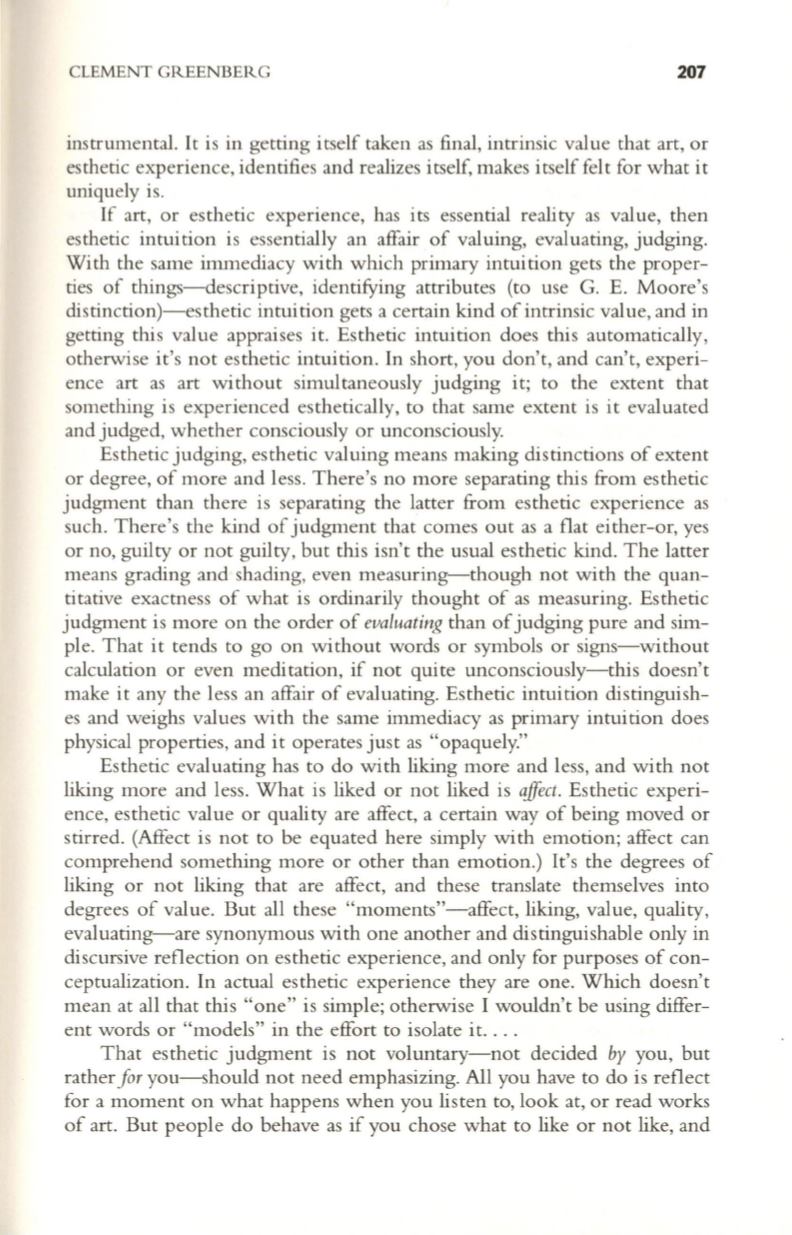
CLEMENT GREENBERG
207
instrumental. It is in getting itself taken as final, intrinsic value that art, or
esthetic experience, identifies and realizes itself, makes itself felt for what it
uniquely is.
If art, or es thetic experience, has its essential reali ty as value, then
esthetic intuition is essentially an affair of valuing, evaluating, judging.
With the same immediacy with which primary intuition gets the proper–
ties of things-descriptive, identifying attributes (to use G. E. Moore's
distinction)-esthetic intuition gets a certain kind of intrinsic value, and in
getting this value appraises it. Esthetic intuition does this automatically,
otherwise it's not esthetic intuition. In short, you don't, and can't, experi–
ence art as art without simultaneously judging it; to the extent that
something is experienced esthetically, to that same extent is it evaluated
and judged, whether consciously or unconsciously.
Esthetic judging, esthetic valuing means making distinctions of extent
or degree, of more and less. There's no more separating this from esthetic
judgment than there is separating the latter from esthetic experience as
such. There's the kind of judgment that comes out as a flat either-or, yes
or no, guilty or not guilty, but this isn't the usual esthetic kind. The latter
means grading and shading, even measuring-though not with the quan–
titative exactness of what is ordinarily thought of as measuring. Esthetic
judgment is more on the order of
evaluating
than of judging pure and sim–
ple. That it tends to go on without words or symbols or signs-without
calculation or even meditation, if not quite unconsciously-this doesn't
make it any the less an affair of evaluating. Esthetic intuition distinguish–
es and weighs values with the same immediacy as primary intuition does
physical properties, and it operates just as "opaquely."
Esthetic evaluating has to do with liking more and less, and with not
liking more and less. What is liked or not liked is
offect.
Esthetic experi–
ence, esthetic value or quality are affect, a certain way of being moved or
stirred. (Affect is not to be equated here simply with emotion; affect can
comprehend something more or other than emotion.) It's the degrees of
liking or not liking that are affect, and these translate themselves into
degrees of value. But all these "moments"-affect, liking, value, quality,
evaluating-are synonymous with one another and distinguishable only in
discursive reflection on esthetic experience, and only for purposes of con–
ceptualization. In actual esthetic experience they are one. Which doesn't
mean at all that this "one" is simple; otherwise I wouldn't be using differ–
ent words or "models" in the effort to isolate it.. . .
That esthetic judgment is not voluntary-not decided
by
you, but
rather
Jar
you-should not need emphasizing. All you have to do is reflect
for a moment on what happens when you listen to, look at, or read works
of art. But people do behave as if you chose what to like or not like, and


